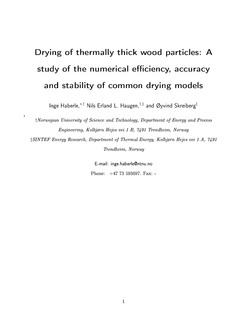| dc.contributor.author | Haberle, Inge | |
| dc.contributor.author | Haugen, Nils Erland L | |
| dc.contributor.author | Skreiberg, Øyvind | |
| dc.date.accessioned | 2018-02-23T07:36:34Z | |
| dc.date.available | 2018-02-23T07:36:34Z | |
| dc.date.created | 2017-11-19T12:46:35Z | |
| dc.date.issued | 2017 | |
| dc.identifier.citation | Energy & Fuels. 2017, 31 (12), 13743-13760. | nb_NO |
| dc.identifier.issn | 0887-0624 | |
| dc.identifier.uri | http://hdl.handle.net/11250/2486595 | |
| dc.description.abstract | The primary focus of this paper is on studying different numerical models for drying of wet wood particles. More specifically, the advantages and disadvantages of the models, with respect to numerical efficiency, stability, and accuracy, are investigated. The two basic models that are studied in detail are the thermal drying model and the kinetic rate drying model. The drying models have been implemented in an in-house simulation tool that solves for drying and devolatilization of a one-dimensional cylindrical wood log. It is found that the choice of drying model can significantly influence the computational time associated with the thermal conversion. Furthermore, the occurrence of numerical pressure oscillations in the thermal drying model has been found and investigated. The numerical oscillations are reduced by introducing an evaporation fraction, fevap. When the thermal drying model is applied, the drying zone is very thin, commonly only including one grid point, which can result in numerical instabilities. The evaporation fraction allows the smearing of the drying zone by reducing the heat flux used for evaporation of liquid water and using the residual heat flux for heating the grid points. Reducing the evaporation fraction also resulted in reduced CPU times. It was found that model accuracy was not significantly influenced by the choice of drying model. | nb_NO |
| dc.language.iso | eng | nb_NO |
| dc.publisher | American Chemical Society | nb_NO |
| dc.title | Drying of Thermally Thick Wood Particles: A Study of the Numerical Efficiency, Accuracy, and Stability of Common Drying Models | nb_NO |
| dc.type | Journal article | nb_NO |
| dc.type | Peer reviewed | nb_NO |
| dc.description.version | acceptedVersion | nb_NO |
| dc.source.pagenumber | 13743-13760 | nb_NO |
| dc.source.volume | 31 | nb_NO |
| dc.source.journal | Energy & Fuels | nb_NO |
| dc.source.issue | 12 | nb_NO |
| dc.identifier.doi | 10.1021/acs.energyfuels.7b02771 | |
| dc.identifier.cristin | 1515709 | |
| dc.relation.project | Norges forskningsråd: 243752 | nb_NO |
| dc.relation.project | Notur/NorStore: NN9405K | nb_NO |
| dc.description.localcode | © American Chemical Society 2017. This is the authors accepted and refereed manuscript to the article. Locked until 7.12.2018 due to copyright restrictions. | nb_NO |
| cristin.unitcode | 194,64,25,0 | |
| cristin.unitname | Institutt for energi- og prosessteknikk | |
| cristin.ispublished | true | |
| cristin.fulltext | postprint | |
| cristin.qualitycode | 2 | |
